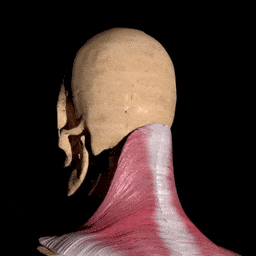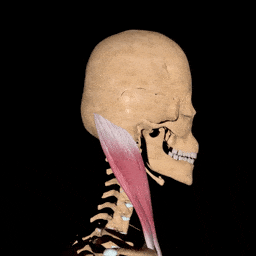Neck Pain & Stretching
Neck pain is a common complaint for people seeking remedial massage. Office Workers make up the lions share of people presenting neck pain. Jun (2009) reports that office workers are 34-49% more likely to experience neck pain than other occupations.
Occupational demands such as prolonged sitting (Gerr et al. 2002) have been linked to increases in neck pain. Astoundingly Blatter & Bongers (2002) report 6 hrs at a computer is associated with an 88% increased chance in neck pain when compared to those who use computers less than 2 hrs.
What Are The Common Symptoms Of Non-Specific Neck Pain?
No big surprise here…. People come in complaining of neck pain!
The spectrum of symptoms can be varied but patients commonly report aching pain in the neck, shoulder or upper back. Patients may experience feelings of stiffness with or without changes in their normal range of motion.
Patients reporting a constant pain complaint over a 24hr period, consistent nerve symptoms in the upper limbs, visual changes or dizziness are all symptoms we keep an eye out for. A major part of managing neck pain is to ensure a patient is safe for treatment first. If a suspicion of a more complex complaint exists, a referral to your doctor of physiotherapist is recommended.
What Are Some Other Common Symptoms?
What Does the Evidence Say About Different Treatment Strategies?
Medication
Drugs such as Paracetamol, Orphenadrine and Diazepam are sometimes used to treat neck pain. In a review by Leaver (2010), a combination of paracetamol & orphenadrine were more effective than placebo for pain relief over an 8 day period. Surprisingly single doses of diazepam were not more effective than a placebo for immediate pain relief.
Relaxation
Techniques such as meditation or ‘body scanning’ are can be used to help manage neck pain symptoms. When considering the evidence, one study (Viljanen et al, 2003) compared relaxation training with dynamic strengthening exercise & with minimal intervention in women with neck pain. When comparing pain outcomes, no significant difference was found between the groups in the short, medium or long term.
Exercise
Leaver reports on several studies looking at the effectiveness of joint manipulation of the neck & / or the mid back. Improvements in pain were seen in the short term when compared to a control group & two studies showed that manual therapy provided better relief than minimal treatment.
Laser Therapy
Leaver’s study reported 8 trials on laser therapy compared to sham laser. 6 trials showed no difference between laser & sham for pain. When pooling the outcomes for 5 studies laser showed statistically significant improvement in the laser group in the medium term. When comparing the laser & sham group, no differences in disability were shown in the short or medium term. Lastly no studies reported longterm outcomes for pain.
Infrared Therapy
Leaver found one study on the use of Infra-red for the treatment of neck pain. When compared to a control group, participants in the treatment group reported greater improvements in pain but only one study (Lewith and Machin, 1981) is reported.
Acupuncture
Several needling acupuncture approaches are reported in Leaven’s review. Chinese practice, western medical practice & trigger point needling were all reviewed. Of the 5 studies reported, acupuncture was not found to be more effective than a control in the treatment of neck pain.
Manipulation
Leaver reports on several studies looking at the effectiveness of joint manipulation of the neck & / or the mid back. Improvements in pain were seen in the short term when compared to a control group & two studies showed that manual therapy provided better relief than minimal treatment.
What Is A Massage Therapists Perspective On The Contributors Of Neck Pain?
Although neck pain can have many causes, it is common for the muscles of the neck to contribute to ongoing discomfort. Massage therapists often work from the book Myofascial pain and dysfunction: the trigger point manual (1992) by Travell & Simons. This manual focuses on pain and its relationship to sensitive areas of muscles known as trigger points.
Palpation of these sensitive areas commonly reproduce a patients pain which is a common indicator for massage therapy to the area. Though the processes at play with regards to the phenomena of trigger points is hotly debated, the mechanism behind their treatment is likely a neurophysiological response. Described by Melzack (1999), a gating affect on the experience of pain can be created through the application of a novel stimulus. Pressure, vibration, heat, cold or massage can all be used to elicit this gating effect. When stimulated, the patient often experiences a decrease in their symptoms which can be a helpful strategy in the management of symptoms. A second mechanism called Descending Inhibition is described Millan (2002) where stimulation of certain nerve fibres can lead to a release of pain mediating chemicals in to the spinal cord. This release of these chemicals in turn leads to a decrease in a patients experience of pain.
Which Muscles Are Of Particular Interest To A Massage Therapist?
The list of muscles that can impact neck pain is exhaustive. Depending on the type of therapist, it is not unusual to hear ‘everything is connected’. A patient with a tight calf, an ankle sprain or a handedness might be contributing to their neck pain.
The ability to make a connection from distant structures to the neck is a difficult one to make. Instead focusing on which muscles are recreating your pain is arguably a more appropriate strategy. The following muscles are a brief summary of some of the muscles commonly treated & prescribed stretches for.
Trapezius
The Trapezius muscle is found across the entire back. Running from the base of the skull, to the tip of the shoulder and down to the lower back.
The upper fibres of this muscle run across the top of the shoulder and along the neck which is an area that is commonly sensitive to pressure. Massaging this area can reproduce your symptoms around your temporal region, side of the neck or across the top of the shoulder.
Levator Scapulae
Attaching from the side of the upper neck to the top corner of your shoulder blade, Lev Scap can help elevate your shoulder blade or tilt your shoulder joint inferiorly.
Areas of tenderness in this muscle can create pain in the side of the neck or to the inside of the shoulder blade.
Sternocleidomastoid
Lets call it the SCM… it’s much easier to say!
The SCM is the muscle that can be seen on the front of the neck that runs up behind the ear. Its role is to rotate the head to the opposite side or extend the neck. Tender areas in this muscle can reproduce pain locally, in the base of the head or to the forehead / brow region.


















